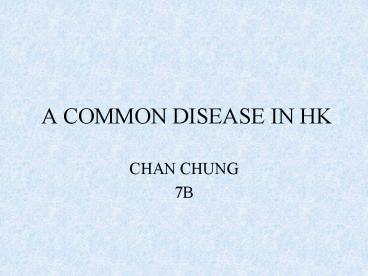A COMMON DISEASE IN HK - PowerPoint PPT Presentation
1 / 24
Title:
A COMMON DISEASE IN HK
Description:
Acute myocardial infarction (a medical term for heart ... acute myocardial infarction. ... 6 hours after the onset of acute myocardial infarction ... – PowerPoint PPT presentation
Number of Views:155
Avg rating:3.0/5.0
Title: A COMMON DISEASE IN HK
1
A COMMON DISEASE IN HK
- CHAN CHUNG
- 7B
2
Acute myocardial infarction (AMI)
- Acute myocardial infarction (a medical term for
heart attack) is the rapid development of
myocardial death caused by a critical imbalance
between the oxygen supply and demand of the
myocardium.
3
- This usually results from plaque rupture with
thrombus formation in a coronary vessel,
resulting in an acute reduction of blood supply
to a portion of the myocardium. It is a
non-infectious disease
4
This is a normal coronary artery with a nice,
big, unobstructed lumen for supplying plenty of
blood to the myocardium.
5
This composite picture demonstrates cross
sections of coronary artery with atherosclerosis.
At the left the lumen is about 50 blocked. At
the left, there has been thrombosis with
organization and recanalization to leave three
small remaining lumens.
6
This cross section of coronary artery
demonstrates 75 narrowing
7
CAUSES
- The most common cause of AMI is narrowing of the
blood vessels due to atheromatous plaques, which
contain cholesterol and deposit on the blood
vessels.
8
- The roughness of these areas may promote platelet
breakdown and sets in motion the clotting
process. This is development of thrombus. This
can result in partial or complete occlusion of
the vessel and cut off the oxygen supply from
blood. This course accounts to about 90 of this
disease.
9
- The other course is the vasospasm (contraction of
the muscular coats of the blood vessels) of the
coronary arteries. This may lead to the slowing
down of blood flow and even rupture of the inner
lining of the coronary arteries and bleed. This
results in thrombosis.
10
This is normal myocardium. There are cross
striations and central nuclei.
11
This is an early acute myocardial infarction.
There is increasing loss of cross striations, and
some contraction bands are also seen.
12
LONG TERM REASONS
- There are several risk factors that are supposed
to increase the incidence of acute myocardial
infarction.
13
- Smoke-----Carbon monoxide and nicotine in the
cigarette allow easier penetration of cholesterol
into blood vessels. - Nicotine narrows the blood vessels, causing an
increase in blood pressure and heart rate. - Carbon monoxide competes with oxygen in the red
blood cells so that there is less oxygen carried
to the heart. Smokers produce more fibrinogen
which greatly stimulates the sticking of blood
platelets on the surface of the inner lining of
the artery.
14
- Obesity-----Excess weight increases the work of
the heart to supply the body with the needed
oxygen. It also raises blood pressure and blood
cholesterol levels which can speed up the
atherosclerotic process.
15
- High blood pressure-------High blood pressure
increases the workload of the heart, causing its
wall to thicken and become stiffer
16
- It has also been shown that people with gout
(caused by high uric acid in the body) has higher
chance of AMI. This is because the uric acid
deposited on the coronary artery and speeds up
the thrombosis
17
SYMPTOMS
- Chest pain,
- Pain may radiate to the jaw, neck, arms, back.
The left arm is affected more frequently than the
right arm. - Anxiety
- Cough
- Nausea and vomiting
- Wheezing
- Elderly patients and those with diabetes may feel
fatigue or weakness.
18
- Sudden death is defined as death occurring within
an hour of onset of symptoms. Such patients tend
to have severe coronary atherosclerosis (75
lumenal narrowing). Often, a complication such as
coronary thrombosis or rupture has occurred. The
mechanism of death is usually an arrhythmia (Loss
or abnormality of rhythm, denoting especially an
irregularity of the heartbeat)
19
TREATMENT
- Antithrombotic agents -- These agents prevent the
formation of thrombus associated with myocardial
infarction and inhibit platelet function by
blocking cyclooxygenase and subsequent
aggregation. Antiplatelet therapy has been shown
to reduce mortality by reducing the risk of fatal
myocardial infarctions, fatal strokes, and
vascular death. Aspirin is one of the example.
20
- Beta blockers -- reduce blood pressure, which
decreases myocardial oxygen demand. These drugs
also reduce the activity of the sympathetic nerve
and hence reduce the workload of the heart.
21
- Thrombolytic(Breaking up or dissolving a
thrombus) agents -- These agents dissolve the
thrombus deposited on the coronary artery to make
the blood flow again and prevent the death of the
myocardium. This kind of treatment works most
efficiently 6 hours after the onset of acute
myocardial infarction
22
PREVENTION
- Having diets with low salt, low cholesterol and
low fat to prevent obesity and lower blood fats - Doing regular exercise can improve heart
function, blood pressure and blood cholesterol
level
23
- Quit smoking
24
END
LSC Good picture, good presentation































